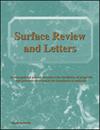磨料水流斜孔阵列流体特性及抛光实验
IF 1.2
4区 材料科学
Q4 CHEMISTRY, PHYSICAL
引用次数: 0
摘要
高温合金上的斜孔阵列在航空发动机上有着重要的应用。然而,在使用热钻孔方法,即电火花钻孔(EDD)制造斜孔时,会出现缺陷,包括重铸层和孔壁上的微裂纹。为此,本文研究了EDD加工高温合金斜孔阵列的磨料水流抛光(AWFP)。设计了两种类型的试样:相同尺寸的孔阵列和相同倾角的孔阵列。流体模拟结果表明,流体向前流动时,斜孔下缘的流体速度和压力显著高于上缘。当进行反向流动时,流体特性呈现相反的趋势。时分双向流动可以有效补偿抛光过程中流场的不均匀性,提高材料去除的一致性。实验结果表明,对于相同倾角的斜孔,由于较大的孔内流体速度和材料去除率较低,尺寸膨胀随孔径的增大而减小。因此,表面粗糙度Ra随孔尺寸的增大而增大。对于相同直径的斜孔,洞口和洞口的扩展尺寸接近同一水平;Ra随倾角的增大而减小。在所有情况下,孔锥度都略有减小。使用1300目尺寸、1.5 wt.%磨料浓度和3 MPa流体压力的石榴石磨料,目标孔的表面粗糙度Ra从抛光前[公式:见文]5.0[公式:见文]m降低到抛光后约1.0[公式:见文]m。由于EDD造成的孔壁重铸层被完全去除。本文章由计算机程序翻译,如有差异,请以英文原文为准。
Fluid characteristics and polishing experiment of inclined hole array using abrasive water flow
Inclined hole arrays on superalloys have important applications in aeroengines. However, defects occur during fabrication of inclined holes using thermal drilling methods, i.e. electrical discharge drilling (EDD), including a recast layer and microcracks on the hole wall. Therefore, abrasive water flow polishing (AWFP) of a superalloy inclined hole array machined via EDD was investigated in this study. Two types of specimens were designed: a hole array of identical size and a hole array with an identical inclination angle. The fluid simulation revealed that the fluid velocity and pressure on the lower edge of the inclined hole were significantly higher than those on the upper edge when the fluid flowed forward. The fluid characteristics exhibited opposite trends when backward flow was implemented. Time-division bidirectional flow can effectively compensate for flow field nonuniformity and improve material removal consistency during polishing. The experimental results show that for inclined holes with identical inclination angles, the size expansion decreases with an increase in the hole diameter owing to the lower fluid velocity and material removal volume in the relatively larger holes. Consequently, surface roughness Ra increases with hole size. For inclined holes with identical diameters, the size expansions of the entrance and exit approach the same level; whereas, Ra decreased with an increase in the inclination angle. The hole taper slightly reduced in all cases. Using garnet abrasives with 1300 mesh size, 1.5 wt.% abrasive concentration, and 3 MPa fluid pressure, the surface roughness Ra of target holes was reduced from pre-polishing [Formula: see text] 5.0[Formula: see text]m to approximately post-polishing 1.0 [Formula: see text]m. The recast layer on the hole wall caused by EDD was completely removed.
求助全文
通过发布文献求助,成功后即可免费获取论文全文。
去求助
来源期刊

Surface Review and Letters
工程技术-物理:凝聚态物理
CiteScore
2.20
自引率
9.10%
发文量
139
审稿时长
4.2 months
期刊介绍:
This international journal is devoted to the elucidation of properties and processes that occur at the boundaries of materials. The scope of the journal covers a broad range of topics in experimental and theoretical studies of surfaces and interfaces. Both the physical and chemical properties are covered. The journal also places emphasis on emerging areas of cross-disciplinary research where new phenomena occur due to the presence of a surface or an interface. Representative areas include surface and interface structures; their electronic, magnetic and optical properties; dynamics and energetics; chemical reactions at surfaces; phase transitions, reconstruction, roughening and melting; defects, nucleation and growth; and new surface and interface characterization techniques.
 求助内容:
求助内容: 应助结果提醒方式:
应助结果提醒方式:


